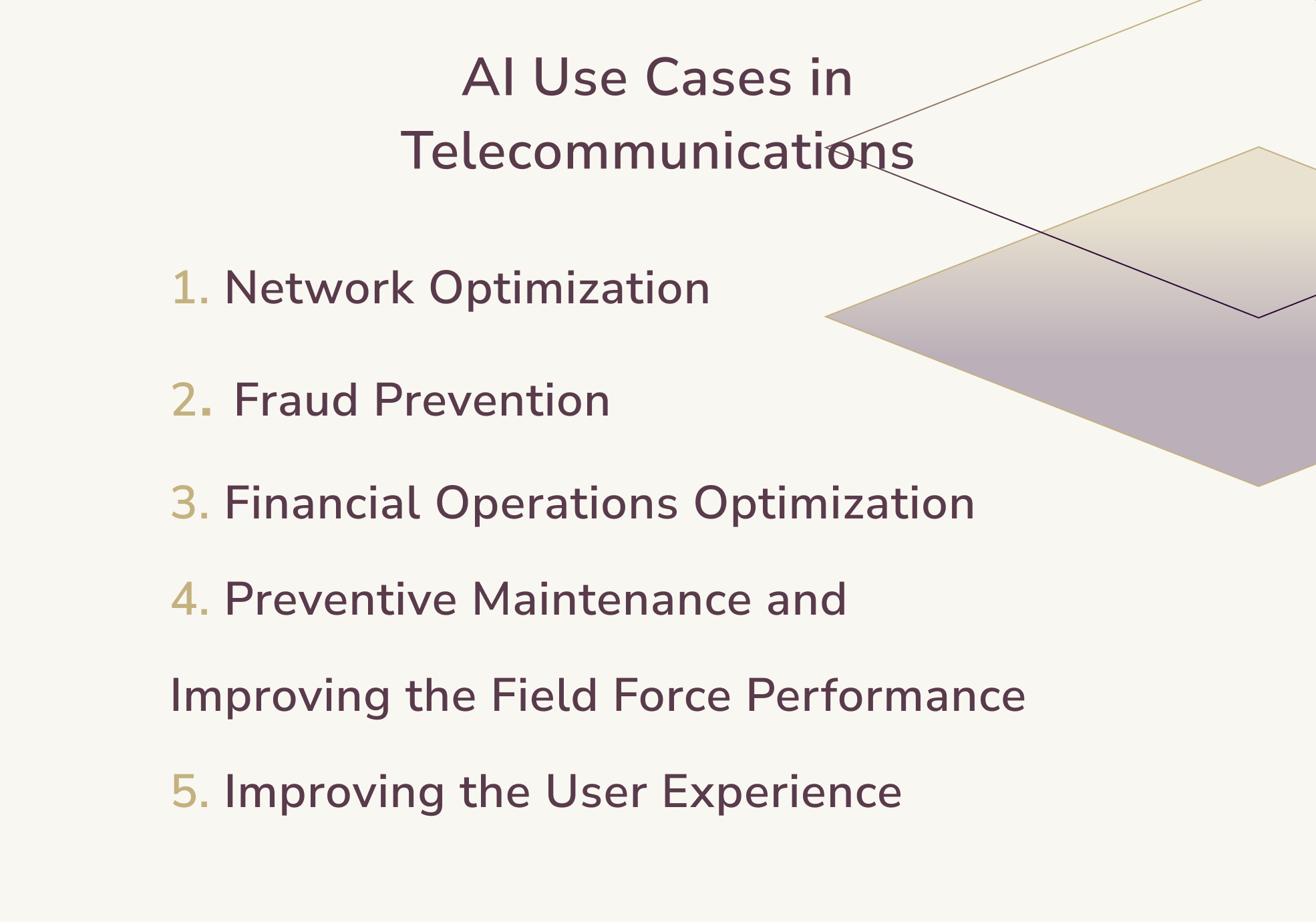Artificial Intelligence (AI) in Telecommunications: Future and Challenges

The latest research by Altman Solon, the largest strategy consulting firm focused on telecommunications, media, and technology, about the use of generative AI in the telecommunication industry states that currently the adoption rate for the tested use cases of generative AI averages 19% but about to increase up to 48% in the next two years. Impressive, right?
Impressive but not surprising. With the adoption of AI becoming the main trend of 2023, it was only a question of time for CPSs (Communication Service Providers) to use the power of this technology to their advantage. Moreover, from 2010 to 2023, according to research by Nathan Benaich of Air Street Capital, the telecom industry invested $19 billion in AI. Market intelligence firm Tractica’s research suggests that telecom AI software revenue is expected to reach more than $11.2 billion in 2025.
So in this article, I would like to dig deeper into the topic of AI usage in the telecommunication field. What are the main challenges the industry faces currently? And how does cutting-edge technology, namely AI, ML, and NLP help to solve the issues that hinder the growth of the telecom industry?
Current Challenges of the Telecom Industry
Most of us are used to living in a connected world. The COVID pandemic once more proved to people how important the telecommunication industry is. Well, the industry itself faces a dynamic landscape with constantly evolving challenges.
Let’s take a look at the most important ones that will definitely determine the direction of the industry's development in the coming years.
Technological Shifts and Disruptions
Ever-evolving technology might be called the blessing and the curse of the telecommunications industry. For example, the rise of the Internet of Things makes it necessary to find ways to manage the massive data generated by interconnected devices and ensure network capacity. It both presents tremendous opportunities for the industry’s growth and development and creates respective challenges regarding the investments and technical advances necessary for this.
Another serious challenge is security and data privacy concerns. Transparent data handling practices and top-notch security measures are of utmost importance for communication service providers. Data breaches and online scams constantly evolve so investing in highly-skilled professionals with expertise in AI and cybersecurity is critical for navigating the digital transformation of the industry.
Meeting Customer Expectations
People easily get used to good services and begin to demand more. In order to stay ahead of the competition, CSPs have to constantly keep the customer satisfaction rate in their focus.
Today, customers crave ever-increasing bandwidth and reliable 5G coverage with remote work and data-heavy applications becoming the norm. In addition to that, moving beyond simply data and voice offerings, people expect tailored plans and bundled services that cater to their individual needs and lifestyles.
And in case customers do experience certain difficulties or disruptions, efficient support and seamless integration across communication channels are essential for one’s customers to stay satisfied and loyal.

Challenges in Finance and Operations
First and foremost, cost reduction and smart resource allocation are crucial for any telecommunication business as constant legacy infrastructure upgrades and maintenance alongside the adoption of new technologies like 5G require significant investment.
Respectively, these significant investments alongside squeezed profit margins (thanks to the saturated market and competitiveness of the industry) make it challenging to both maintain profitability and offer competitive prices.
New Regulations and Geopolitical Tensions
The adoption of GDPR in 2018 was one of the major events that influenced the business of every CSP in Europe. For instance, internet providers were obliged to update their cloud services and processes to ensure the privacy and security of user data. Following a complex system of data privacy laws across different regions is complicated and might be costly.
One of the bright examples is the new UK ‘One Touch Switch’ regulation introduced by Ofcom in September 2021. According this program, users should be able to switch providers to get a faster package, cheaper deal, or better customer service faster and just by contacting a new provider. This change is highly complex and challenging for providers all over the UK.
Global political and economic factors can disrupt the supply chain of critical equipment and raise concerns about network infrastructure security. Not to mention the challenge of bringing connections to underdeveloped countries and regions around the world.
The telecom industry must continuously adapt and innovate to overcome these challenges. One of the ways to do it is to use the benefits that artificial intelligence and machine learning are able to offer.
AI in Telecommunications: Use Cases
AI is a relatively young discipline as its history goes back to the 1940s. However, it managed to catch the attention of the broad public only a few years ago.
Businesses, on the other hand, recognized the potential of AI much earlier. Thus, in the telecommunications industry, North American CSPs lead AI adoption with an average use case adoption of 21% while European CSPs are slightly behind (19% average use case adoption). Considering limited capabilities in non-English languages of existing generative AI models, the APAC region with 16% of average use case adoption does look very promising as well.
But what are the exact use cases we are talking about here? How AI can help telecoms overcome the aforementioned challenges and boost businesses?
Network Optimization
Enhanced cost-effectiveness, improved network performance, greater agility, and responsiveness — doesn’t this sound like a dream for each and every one of telecom operators? The future is now, and namely, AI has the potential to empower CSPs to achieve efficient and dynamic network management.
Network optimization with AI can include the following:
- Network monitoring in real-time. Constant real-time monitoring of network performance with AI tools analyzing vast volumes of network data, including traffic patterns, device uptime and downtime, responsiveness, and resource utilization. Сontinuous service delivery and minimization of human factors are possible with artificial intelligence algorithms that automatically diagnose and resolve network issues.
- Automated configuration changes. Using real-time data and a set of predefined rules, AI is able to automatically adjust network configurations helping to reduce manual workload and costs.
- Personalized network experiences. CPSs would be able to offer and deliver more dynamic and responsive experiences for each user with the help of AI that can tailor special packages with dynamic traffic based on individual use patterns, needs, and preferences.
- 5G network optimization. AI is able to help dynamically adjust capacity, prioritize critical data flows, and ensure low latency and high bandwidth.
- Content caching and delivery optimization. Delivering content faster and reducing network load is possible with AI tools that might optimize content caching strategies based on specific predetermined patterns.
Fraud Prevention
According to the Communications Fraud Control Association, in 2023, telecommunications fraud increased 12% equating to an estimated $38.95 billion in losses. Currently, manual analysis of limited data is widely used as a method of fraud detection. However, the introduction of AI for this purpose might lower the losses connected to fraud significantly.
Generally speaking, not only AI tools are able to reduce fraud losses but also to:
- Improve customer experience by responding to fraud attempts faster;
- Enhance network security because proactive identification of suspicious activity strengthens overall network security;
- Streamline operations with AI performing mundane and time-consuming tasks and human workforce focusing on complex investigations.
Possible AI use cases for fraud detection and prevention include:
- With the help of Machine Learning algorithms, it will be possible to analyze vast amounts of network traffic and customer data, identifying patterns and anomalies indicative of fraud.
- AI can monitor call logs, data usage, and financial transactions 24/7 in real-time, flagging suspicious activity in real-time for immediate action.
- Future fraud attempts can be predicted by analyzing historical data and identifying emerging trends.
Financial Operations Optimization
Just as in any other industry, in telecommunications, AI is able to help optimize finances. Except for the help with pricing and bundling, fraud detection and prevention, and targeted marketing and upselling, consider using AI for the following:
- Predictive maintenance and churn prevention. Using various AI tools allows for proactive maintenance and churn prevention strategies.
- Resource allocation and expense optimization with AI identifying areas for cost-saving opportunities, suggesting optimal resource allocation, workforce scheduling, and vendor contracts.
- Financial forecasting and risk management. It is possible to use machine learning to analyze historical data and market trends to generate accurate financial forecasts, predict future risks, and make informed investment decisions.
- Compliance and regulatory adherence. According to this article, automated AI compliance checks and reporting ensure adherence to financial regulations and minimize the risk of penalties or non-compliance issues.

Preventive Maintenance and Improving the Field Force Performance
The efficiency and safety of field telecommunications engineers are critical for maintaining seamless connectivity and minimizing downtime. AI with its predictive capabilities and actionable insights might become a game-changer that boosts field force performance. However, it should be noted that AI should complement and empower field technicians, not replace them.
Let's take a closer look at how AI can be utilized to do it:
- Predictive analytics. AI is able to continuously monitor network infrastructure and identify sudden changes in data patterns and predict potential equipment failures by analyzing historical data on equipment performance, environmental factors, and usage patterns.
- Resource optimization. Maintenance systems powered by AI can be used to optimize spare parts inventory, technician schedules, and maintenance routes.
- Real-time data access. Field technicians can use AI-powered apps with instant access to maintenance manuals, equipment history, and relevant network data that would help them to make informed decisions quickly and efficiently.
- Automated reporting and documentation. Reduce time spent filling mundane reports and let engineers focus on repairs and maintenance with AI automatically filling out forms and generating reports based on collected data.
- Training and knowledge management. Why not use AI platforms for training and sharing best practices and troubleshooting techniques from experienced technicians? This might result in consistent quality of service and knowledge transfer across the field force.
Improving the User Experience
As mentioned before, the elevation of the user experience is one of the challenges that drive the telecommunication industry to look for new ways to improve their services. However, one should keep in mind that the implementation of AI requires careful planning, ethical considerations, and a focus on data privacy.
So how can telco companies utilize the power of AI to improve customer experience?
- Virtual assistants and chatbots. They can reduce wait times and consequently increase customer satisfaction. AI-powered assistants can handle routine inquiries and resolve simple issues 24/7 which might free more time for customer service representatives to solve more complex issues.
- Sentiment analysis. A better understanding of customers’ pain points and proactive addressing of their concerns are possible with the analysis of customer feedback and social media interactions.
- Targeted marketing and promotions. AI can help one’s marketing team to make more impactful and effective campaigns by identifying customer segments and tailoring more relevant offers and incentives.
In Conclusion
In conclusion, the telecommunications industry is facing a multitude of challenges, including technological shifts, meeting customer expectations, financial constraints, and regulatory compliance. However, the adoption of artificial intelligence (AI) offers promising solutions to these obstacles.
AI is already making significant strides in the industry, particularly in areas such as network optimization, fraud prevention, financial operations, preventive maintenance, and improving user experience. By leveraging AI tools and technologies, communication service providers (CSPs) can enhance network efficiency, detect and prevent fraud more effectively, optimize financial operations, improve field force performance, and elevate the overall user experience.
Despite the impressive potential of AI, its successful implementation requires careful planning, consideration of ethical implications, and a focus on data privacy. Nevertheless, with the increasing adoption rates predicted in the coming years, AI is poised to become an indispensable tool for driving innovation and growth in the telecommunications industry, ultimately leading to improved services and customer satisfaction.

Max Shpak
Other articles